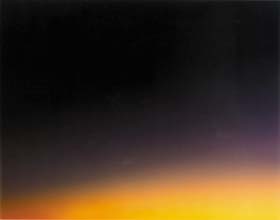 Looking at the enormous sky above the ocean at Cape May, today, I am reminded of my tour of galleries in Center City last week. What passes for landscapes, in the modern art world, are skyscapes at heart (see Michael Pyrdsa’s “Miles from Nowhere,” here, at 96 inches wide, offering a vast expanse of untilled sky over a vertiginous stretch of unpopulated, but heavily farmed land).
Looking at the enormous sky above the ocean at Cape May, today, I am reminded of my tour of galleries in Center City last week. What passes for landscapes, in the modern art world, are skyscapes at heart (see Michael Pyrdsa’s “Miles from Nowhere,” here, at 96 inches wide, offering a vast expanse of untilled sky over a vertiginous stretch of unpopulated, but heavily farmed land).
Pyrdsa’s paintings at Gross-McCleaf weren’t the only dominant skies on view.
At the Creative Artist’s Network’s tiny weeklong show at 1701 Market (see post for TK) I saw Ben Johnson’s skyscapes, pale tan and almost the same color as land, represented by just a thin stripe of land across the bottom of the paintings; I saw Dominic Episcopo’s tiny Polaroid, “Golf Range #1”, a bit of fence dominated by a purply-pink sky; I saw Diane Tomash’s monotype, “Sleepy Town,” which was mostly sleepy sky.
 And then I thought of the “Sea and Sky” show at Beaver College (now Arcadia) two years ago (shown here, a piece from one of that show’s artists, Richard Misrach).
And then I thought of the “Sea and Sky” show at Beaver College (now Arcadia) two years ago (shown here, a piece from one of that show’s artists, Richard Misrach).
Why sky? It’s tough to do an idyllic landscape with a nice little path representing the road of life in a landscape that is littered with detritus from industry, landfills, suburban sprawl, and concrete highway superstructures interrupting every square mile.
But the sky still looks like sky (and the sea still looks like sea). And out there is the edge of so-called civilization, in rockets, airplanes and space stations. It’s still a symbol for the romantic adventure and the hope for the future—because it stretches the limits of human understanding.
That star out there may be where we settle next. That rocket ship may be our only path to life after the nuclear disaster that destroys us. It’s the small man in the vastness to a degree no landscape offers in these times of instant messaging and instant remote transmission from the war in Iraq.
Which is not to say that there aren’t any modern landscapes left. But their subject matter is depressed, elegiac, angry. For the classical landscape and its impulses, artists are looking up.









